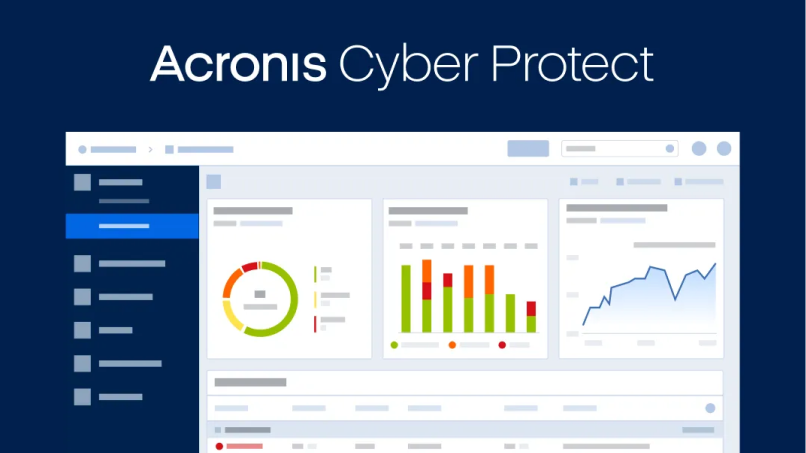
SQL server backup and disaster recovery

- Enhanced data protectionEnsure business continuity with hybrid protection that improves disaster recovery.
- Flexible and secure backup storageBack up, capture, store, recover, control and access SQL data in virtual, physical, cloud and mobile environments.
- Easy, reliable backup and recoveryFortify IT and user productivity with fast, simple backup and recovery.
SQL server backup and recovery with Acronis Cyber Protect
- Disk-image technologyAcronis’ patented disk image technology unites disk and SQL database backups into one high-performance, efficient solution.
- Single-pass backupsCapture operating systems, files, the SQL database and applications at one time with single-pass, imaged-based backup.
- Back up anywherePerform backups to local disk, network share, tape and cloud storage. Acronis SQL backup scales with your business.
- Rapid recoveryAcronis’ SQL-aware recovery interface enables you to rapidly and seamlessly recover a database, files, disk or complete server.
- SQL recovery catalogAutomatically generate SQL-related catalogs so you can search for and pinpoint SQL server instances and database versions — to ensure you recover with speed.
- Mounting databases without restoringSwiftly access information by mounting a SQL database directly from the backup repository. The backed-up database is attached in read-only mode.
- Acronis Active RestoreUsers can start working before the restore is complete. Critical data is recovered with the highest priority while the rest recovers in the background.
- Modular architectureEnjoy flexible and tailored data protection that lets you add Acronis Backup Advanced products to your core solution as your business grows.

Watch Acronis Cyber Protect in action
See for yourself: Acronis SQL backup and recovery.
Explore integrated cyber protection that holistically secures Microsoft SQL server environments and ensures fast recovery.
Solutions
Centralized cyber protection solution to streamline your endpoint protection, backup and disaster recovery, and management through integration and automation.
Integrated cyber protection platform unifying cybersecurity, data protection and management to reduce complexity, streamline your services and cut costs.
What our customers say 4.8
Unleash industry-proven protection for your business



Looking for help?
Frequently Asked Questions
What are the consequences of SQL data loss?
SQL data loss can have costly and debilitating ramifications for businesses. Poor backup processes and a lack of comprehensive security can result in the following:
• Unanticipated downtime.
• Susceptibility to cybercriminal extortion.
• Regulatory fines.
• Reputational damage.
• Failure to qualify for cyber insurance.What is a full SQL backup?
A full SQL backup creates a complete backup of an entire SQL server database. The backup includes all data, objects and settings within the database to ensure it can be restored in its entirety and exact state at the time of backup.
In a full SQL backup, the complete database is captured, including tables, views, stored procedures, triggers, indexes and other components. Collectively, this provides a comprehensive snapshot of the database and empowers IT professionals to holistically recover the SQL database in the event of loss, system failures, cyberattacks, natural disasters or unanticipated circumstances.How to back up an SQL server to the cloud in 5 steps
1. Select a cloud storage provider that offers storage services compatible with SQL server backups and with your growing business’ needs.
2. Set up, create and configure a storage repository or bucket in your cloud provider’s platform that will be designated to store SQL server backup files.
3. Specify the cloud storage as the backup destination and provide connection details and credentials for your cloud storage repository. This ensures that the backed-up files are securely stored directly in the cloud.
4. Schedule regular backups that best fit your business’ requirements, needs and compliance regulations. Backups can be performed daily or weekly according to your organization’s data retention and recovery objectives.
5. Test, verify, monitor and maintain backups. Adjust configurations and ensure that backups are being performed successfully. Regularly monitor and provision backup processes to make sure backups are stored properly in the cloud.How to configure Acronis for MySQL backups
1) Create a new backup plan: Open Acronis and navigate to the backup plan creation section. Choose to create a new backup plan.
2) Select backup source: Choose the MySQL database as the source of the backup. You may need to provide the connection details, including the server address, port, username and password.
3) Backup options: full or incremental: Decide whether you want full backups (entire database) or incremental backups (only changes since the last backup).
4) Scheduling: Set up a schedule for the backups. This can be daily, weekly or at any custom interval.
5) Storage destination: Choose where the backups will be stored. This can be on a local disk, network storage or a cloud storage service supported by Acronis.
6) Backup validation: Enable automatic validation of backup files to ensure data integrity.
7) Encryption and security: Configure encryption settings for securing your backup files, if necessary.What is the difference between high availability and disaster recovery in an SQL server?
High availability is the ability of a system or database to remain operational and accessible with minimal downtime to the organizations. When it comes to SQL servers, high availability solutions are purpose built to mitigate downtime by offering redundancy and failover capabilities. If one server or component fails, this ensures another server takes over and allows for continuous access to databases.
Disaster recovery focuses on the restoral and recovery of data following severe natural disasters and catastrophic events. It incorporates having a plan and infrastructure in place to recover the database quickly and return operations to a functional state. This includes restoring backups to a different server or location to ensure data integrity and business continuity in a disaster.What is the best way to recover SQL servers from a backup? (Acronis Cyber Protect)
Acronis enables fast, seamless and reliable recovery with three features:
1. The SQL-aware recovery interface empowers organizations and IT security professionals to quickly recover databases, files, disks or complete servers with Acronis’ user-friendly interface.
2. The SQL recovery catalog automatically generates an SQL-related catalog so you can search and find SQL instances and database versions — helping to further ensure quick recovery.
3. Disaster recovery empowers your business to recover your SQL server in minutes to the same location, to dissimilar hardware or to a virtual server. Rapidly restore data locally or remotely. Additionally, Acronis’ fast bare metal restore lets you recover an entire server in minutes in case of hardware failure or natural disaster.
Sorry, your browser is not supported.
It seems that our new website is incompatible with your current browser's version. Don’t worry, this is easily fixed! To view our complete website, simply update your browser now or continue anyway.
